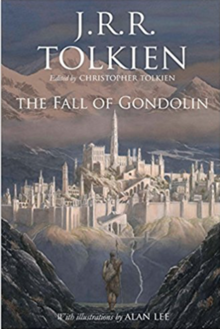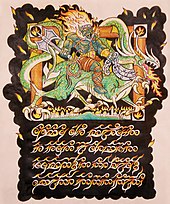
Christopher John Reuel Tolkien was an English and naturalised French academic editor. The son of author and academic J. R. R. Tolkien, Christopher Tolkien edited much of his father's posthumously published work, including The Silmarillion and the 12-volume series The History of Middle-Earth. Tolkien also drew the original maps for his father's The Lord of the Rings.
A Balrog is a powerful demonic monster in J. R. R. Tolkien's Middle-earth. One first appeared in print in his high-fantasy novel The Lord of the Rings, where the Fellowship of the Ring encounter a Balrog known as Durin's Bane in the Mines of Moria. Balrogs appear also in Tolkien's The Silmarillion and other posthumously published books. Balrogs are tall and menacing beings who can shroud themselves in fire, darkness, and shadow. They are armed with fiery whips "of many thongs", and occasionally use long swords.
In J. R. R. Tolkien's fictional legendarium, Beleriand was a region in northwestern Middle-earth during the First Age. Events in Beleriand are described chiefly in his work The Silmarillion, which tells the story of the early ages of Middle-earth in a style similar to the epic hero tales of Nordic literature, with a pervasive sense of doom over the character's actions. Beleriand also appears in the works The Book of Lost Tales, The Children of Húrin, and in the epic poems of The Lays of Beleriand.
In J.R.R. Tolkien's legendarium, Gondolin is a secret city of Elves in the First Age of Middle-earth, and the greatest of their cities in Beleriand. The story of the Fall of Gondolin tells of the arrival there of Tuor, a prince of Men; of the betrayal of the city to the dark Lord Morgoth by the king's nephew, Maeglin; and of its subsequent siege and catastrophic destruction by Morgoth's armies. It also relates the flight of the fugitives to the Havens of Sirion, the wedding of Tuor and the Elf Idril, and the childhood of their son Eärendil.

Unfinished Tales of Númenor and Middle-earth is a collection of stories and essays by J. R. R. Tolkien that were never completed during his lifetime, but were edited by his son Christopher Tolkien and published in 1980. Many of the tales within are retold in The Silmarillion, albeit in modified forms; the work also contains a summary of the events of The Lord of the Rings told from a less personal perspective.
Túrin Turambar is a fictional character in J. R. R. Tolkien's legendarium. Turambar and the Foalókë, begun in 1917, is the first appearance of Túrin in the legendarium. Túrin is a Man of the First Age of Middle-earth, whose family had been cursed by the Dark Lord Morgoth. While trying vainly to defy the curse, Túrin brings ruin across much of Beleriand, and upon himself and his sister Niënor. His title, "Turambar", means master of fate.
Tuor Eladar and Idril Celebrindal are fictional characters from J. R. R. Tolkien's Middle-earth legendarium. They are the parents of Eärendil the Mariner and grandparents of Elrond Half-elven: through their progeny, they become the ancestors of the Númenóreans and of the King of the Reunited Kingdom Aragorn Elessar. Both characters play a pivotal role in The Fall of Gondolin, one of Tolkien's earliest stories; it formed the basis for a section in his later work, The Silmarillion, and was expanded as a standalone publication in 2018.
In J. R. R. Tolkien's Middle-earth, the Eagles or Great Eagles, are immense birds that are sapient and can speak. The Great Eagles resemble actual eagles, but are much larger. Thorondor is said to have been the greatest of all birds, with a wingspan of 30 fathoms. Elsewhere, the Eagles have varied in nature and size both within Tolkien's writings and in later adaptations.
Húrin is a fictional character in the Middle-earth legendarium of J. R. R. Tolkien. He is introduced in The Silmarillion as a hero of Men during the First Age, said to be the greatest warrior of both the Edain and all Men in Middle-earth. His actions, however, bring catastrophe and ruin to his family and to the people of Beleriand.
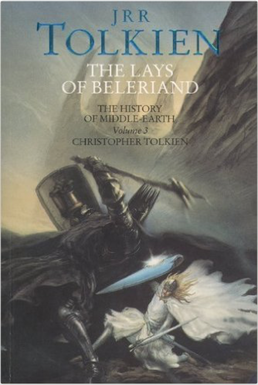
The Lays of Beleriand, published in 1985, is the third volume of Christopher Tolkien's 12-volume book series, The History of Middle-earth, in which he analyzes the unpublished manuscripts of his father J. R. R. Tolkien.
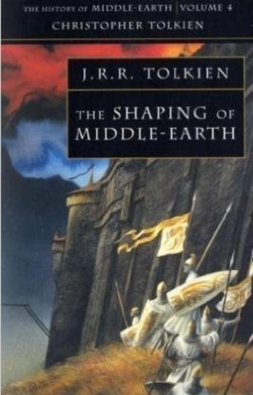
The Shaping of Middle-earth – The Quenta, The Ambarkanta and The Annals (1986) is the fourth volume of Christopher Tolkien's 12-volume series The History of Middle-earth in which he analysed the unpublished manuscripts of his father J. R. R. Tolkien.
The following outline is provided as an overview of and topical guide to the real-world history and notable fictional elements of J. R. R. Tolkien's fantasy universe. It covers materials created by Tolkien; the works on his unpublished manuscripts, by his son Christopher Tolkien; and films, games and other media created by other people.
The term Middle-earth canon, also called Tolkien's canon, is used for the published writings of J. R. R. Tolkien regarding Middle-earth as a whole. The term is also used in Tolkien fandom to promote, discuss and debate the idea of a consistent fictional canon within a given subset of Tolkien's writings.

Beren and Lúthien is a compilation of multiple versions of the epic fantasy Lúthien and Beren by J. R. R. Tolkien, one of Tolkien's earliest tales of Middle-earth. It is edited by Christopher Tolkien. It is the story of the love and adventures of the mortal Man Beren and the immortal Elf-maiden Lúthien. Tolkien wrote several versions of their story, the last in The Silmarillion, and the tale is also mentioned in The Lord of the Rings at the council of Elrond. The story takes place during the First Age of Middle-earth, about 6,500 years before the events of The Hobbit and The Lord of the Rings.
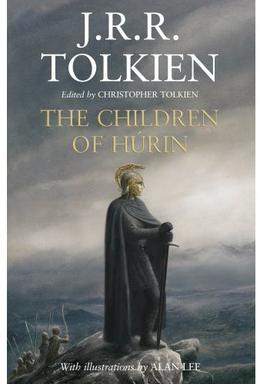
The Children of Húrin is an epic fantasy novel which forms the completion of a tale by J. R. R. Tolkien. He wrote the original version of the story in the late 1910s, revising it several times later, but did not complete it before his death in 1973. His son, Christopher Tolkien, edited the manuscripts to form a consistent narrative, and published it in 2007 as an independent work. The book is illustrated by Alan Lee. The story is one of three "great tales" set in the First Age of Tolkien's Middle-earth, the other two being Beren and Lúthien and The Fall of Gondolin.
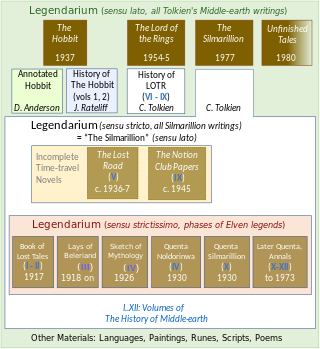
Tolkien's legendarium is the body of J. R. R. Tolkien's mythopoeic writing, unpublished in his lifetime, that forms the background to his The Lord of the Rings, and which his son Christopher summarized in his compilation of The Silmarillion and documented in his 12-volume series The History of Middle-earth. The legendarium's origins reach back to 1914, when Tolkien began writing poems and story sketches, drawing maps, and inventing languages and names as a private project to create a unique English mythology. The earliest story drafts are from 1916; he revised and rewrote these for most of his adult life.
The Maiar are a fictional class of beings from J. R. R. Tolkien's high fantasy legendarium. Supernatural and angelic, they are "lesser Ainur" who entered the cosmos of Eä in the beginning of time. The name Maiar is in the Quenya tongue from the Elvish root maya- "excellent, admirable".
Morgoth Bauglir is a character, one of the godlike Valar, from Tolkien's legendarium. He is the main antagonist of The Silmarillion, The Children of Húrin, Beren and Lúthien, and The Fall of Gondolin.

The Silmarillion is a collection of myths and stories in varying styles by the English writer J. R. R. Tolkien. It was edited and published posthumously by his son Christopher Tolkien in 1977, assisted by the fantasy author Guy Gavriel Kay. It tells of Eä, a fictional universe that includes the Blessed Realm of Valinor, the once-great region of Beleriand, the sunken island of Númenor, and the continent of Middle-earth, where Tolkien's most popular works—The Hobbit and The Lord of the Rings—are set. After the success of The Hobbit, Tolkien's publisher, Stanley Unwin, requested a sequel, and Tolkien offered a draft of the writings that would later become The Silmarillion. Unwin rejected this proposal, calling the draft obscure and "too Celtic", so Tolkien began working on a new story that eventually became The Lord of the Rings.
